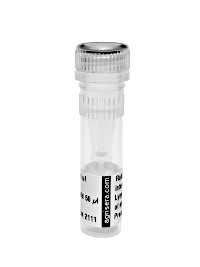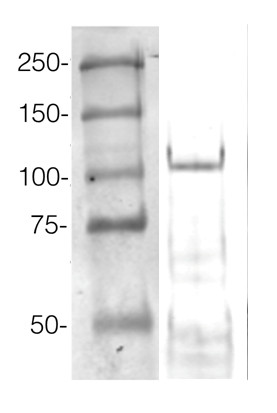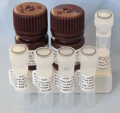1

AGO1 | Argonaute 1, Blocking peptide
AS09 527P | Blocking peptide
- Product Info
-
Format: Lyophilized Quantity: 100 µg Reconstitution: For reconstitution please add sterile water Storage: Store lyophilized/reconstituted at -20°C; once reconstituted make aliquots to avoid repeated freeze-thaw cycles. Please remember to spin the tubes briefly prior to opening them to avoid any losses that might occur from material adhering to the cap or sides of the tube. Tested applications: Neutralization assay (NeA) Expected | apparent MW: 1716.9 Da - Additional Information
-
Additional information: Estimation of the ratio between antibodies and peptide : In neutralisation assay use 9.16 µg of argonaute 1 peptide for 10 ml of reaction volume.
In case of any questions please contact [email protected]Additional information (application): Due to its low molecular weight, this peptide is not suitable for separation on a SDS gel, - Background
-
Background: This blocking peptide can be used as a control to neutralize AGO1 | argonaute 1 before immunolocalization or western blot. Furter details are provided below.
AGO1 belongs to a group of argonaute proteins which are catalytic component of the RNA-incudes silencing complex (RISC). This protein complex is responsible for the gene silencing (RNAi). - Protocols
-
Peptide neutralization assay
TCA/Acetone protein precipitation method for plant proteins- Grind plant tissue in a liquid nitrogen.
- Continue grinding with 10% TCA solution in acetone (ice cold).
- Precipitate overnight in -20C.
- Spin at 4°C for 1min, 17k rpm > wash with ice cold acetone until you obtain a white pellet.
- Dissolve the pellet in buffer of choice (for example 8M urea containing 5mM DTT, or denaturate in SDS protein loading buffer for 10 min. at 70°C)
- Clarify supernatant
- Measure protein concentration.
- Proceed with a western blot.
Example of a western blot result obtained with this method, which allows high protein load per well, can be found below.

360 µg/well of Arabidopsis thaliana protein extracted by TCA-acetone precipitation from floral tissue and saturated in 8M urea were separated on 15% SDS-PAGE and blotted for 1hour to 0.2 µm nitrocellulose at 100V using wet transfer system. Blots were blocked with 0.5% cold fish gelatin for 1hr at room temp with agitation. Blot was incubated in the primary antibody at a dilution of 1:2500 for an hour at RT with agitation. The blots were washed with 3X 15min TBS-TT at RT with agitation. Blots as incubated in the secondary antibody (DayLight 800) 1:5000 dilution for 30 min. at RT with agitation and washed 1X with TBSTT for 15 min, 1X with TBST for 15min before scanning with the ODyssey IRD scanner.
Courtesy of Dr. Betty Chung and Pawel Baster, University of Cambridge, United Kingdom
BACK to Plant Protocols page - Reviews:
-
Katarzyna Niedojadło | 2013-02-27I checked this antibodies by immunocytochemistry but I have many problems with Western blotting.
Accessories

AS09 527 | Clonality: Polyclonal | Host: Rabbit | Reactivity: Arabidopsis thaliana, Nicotiana benthamiana

AS09 527-HRP | Clonality: Polyclonal | Host: Rabbit | Reactivity: Arabidopsis thaliana, Nicotiana benthamiana

This set contains:
- 4 Anti-AGO antibodies of your choice, chosen from a drop down menu below
- Matching secondary antibody, HRP conjugated, min. 1: 25 000, 1h/RT (AS09 602 - trial)

